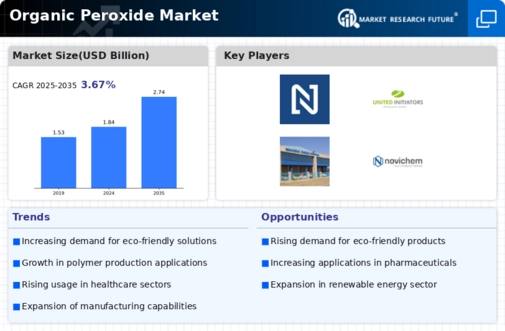Top Industry Leaders in the Organic Peroxide Market
 Organic peroxides, though often unseen, play a crucial role in our everyday world, from the tires we ride on to the polymers in our phones. This market fuels diverse applications: polymerization initiators, curing agents, bleaching agents, and even explosives. But beneath the seemingly stable surface of these reactive molecules lies a dynamic landscape where established players and nimble startups grapple for market share amidst evolving trends, safety concerns, and technological advancements. Let's explore the strategies, factors, and recent developments shaping this explosive and intriguing realm.
Organic peroxides, though often unseen, play a crucial role in our everyday world, from the tires we ride on to the polymers in our phones. This market fuels diverse applications: polymerization initiators, curing agents, bleaching agents, and even explosives. But beneath the seemingly stable surface of these reactive molecules lies a dynamic landscape where established players and nimble startups grapple for market share amidst evolving trends, safety concerns, and technological advancements. Let's explore the strategies, factors, and recent developments shaping this explosive and intriguing realm.
Strategies Detonating Market Share:
-
Product Diversification: Leading players like AkzoNobel, Arkema, and Nouryon are constantly expanding their offerings, developing customized organic peroxides with tailored reactivity profiles and functionalities for specific applications. Think low-temperature initiators for cold cure processes, high-purity peroxides for electronics, and environmentally friendly alternatives for sustainable production. -
Safety Focus: Stringent regulations and environmental consciousness demand responsible handling. Companies are investing in advanced production processes, improved storage and transportation solutions, and the development of inherently safer organic peroxides with reduced decomposition temperatures and environmental impact. -
Vertical Integration: Securing reliable sources of key raw materials like hydrogen peroxide and organic acids is crucial. Companies like Evonik and Pergan are investing in backward integration to gain control over the supply chain and optimize costs. -
Geographical Expansion: Emerging economies in Asia and Africa present immense growth potential, driven by expanding manufacturing activities and rising disposable incomes. Companies like Shandong Luyuan Chemical and Jubilant Ingrevia are establishing production facilities and forging partnerships in these regions to capitalize on this trend.
Factors Influencing Market Growth:
-
End-User Industries: Plastics and elastomers remain the primary drivers, consuming over 60% of global organic peroxide production. Growing demand for durable plastics for construction and automotive applications contributes to this demand. -
Regulation and Safety: Stringent regulations on chemical handling, emissions, and worker safety, like REACH in Europe and TSCA in the US, drive the development of safer and compliant organic peroxides. Companies meeting these standards gain a competitive edge. -
Technological Advancements: Research and development efforts are leading to novel catalysts, improved synthesis methods, and the development of bio-based organic peroxides with lower environmental impact. Early adopters and innovators stand to benefit significantly from these advancements. -
Resource Availability: Fluctuations in the prices and availability of key raw materials can significantly impact production costs and market dynamics. Companies with diverse sourcing networks and alternative technologies have an advantage.
Key Companies in the Organic Peroxide market include
- United Initiators GmbH (Germany)
- Pergan (Germany)
- Arkema (France)
- Akzonobel N.V. (Netherlands)
- NOF Corporation (Japan)
- MPI Chemie B.V. (Netherlands)
- AKPA KIMYA (Turkey)
- Ace Chemicals (India)
- Plastic Pigments Pvt. Ltd. (India)
- Novichem (Poland)
- As-Ambalaj (Turkey)
- R.T. Vanderbilt Holding Company, Inc. (U.S.)
- Kawaguchi Chemical Industry Co., LTD. (Japan)
Recent Developments
-
September 2023: The European Commission proposes stricter regulations on occupational exposure limits for organic peroxides, prompting research into safer handling procedures and improved personal protective equipment. -
October 2023: AkzoNobel unveils a new line of low-volatile organic peroxides for electronics production, reducing hazardous emissions and contributing to a cleaner environment. -
November 2023: A consortium of leading universities and chemical companies launches a collaborative project to develop bio-based catalysts for organic peroxide synthesis, aiming to minimize reliance on fossil fuels and reduce environmental impact. -
December 2023: The Organic Peroxide market exhibits cautious optimism for continued growth in 2024, driven by increasing demand, technological advancements, and a growing focus on safety and sustainability. However, uncertainties in resource availability and evolving regulations require careful monitoring.

